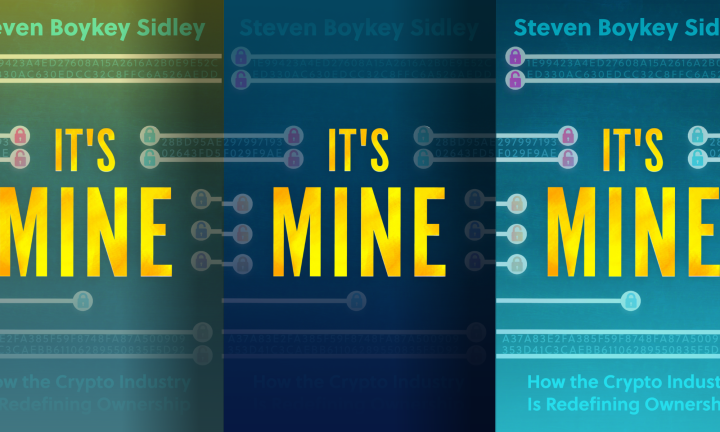BOOK EXCERPT
It’s evolution, baby. We’re watching a transformative techno-societal change in real time

Steven Boykey Sidley has written a brilliant book to help us understand blockchain technology and how it changes the rules of ownership — and so much more.
The words “crypto”, “blockchain” or “Bitcoin” have the ability to elicit a Marmite effect in anyone reading them: you either love it or you hate it. Regarding the latter, such reaction to new technology is often fuelled by a fear of change, as well as the fact that this new tech can be so darn difficult to understand.
The good news is, just like with life-changing apps such as Uber, Airbnb and Spotify, you don’t need to understand the mechanisms of the tech to enjoy its benefits.
It’s Mine: How the crypto industry is redefining ownership, by Steven Boykey Sidley, explains why blockchain technology is changing the ownership game and why there’s nothing to fear. Except perhaps, your current situation: do you really own what you think you own?
Read the excerpt below.
***
The ground on which the creatures walk
Like most people going about their business in the early 2020s, concerned and dispirited by the pandemic and political polarisation and the disturbing mutations of power wrought by social media, the emergence of a squealing baby called NFTs was a small bewilderment.
I was already deep into blockchain technology and its combustive innovations, having just finished a book with co-writer Simon Dingle called Beyond Bitcoin: Decentralised Finance and the End of Banks. But this new blockchain-borne species was a mote in the corner of my eye, lightly disturbing my view of the future. What were they doing? Who were these people paying seemingly irrational amounts for sometimes questionable collections of pixels on a screen?
It didn’t stop there. There was a continuing confusion of new amorphous shapes forming around crypto innovations – tantalising hints of a new sort of Internet, opportunities to own a piece of immersive virtual worlds, new ways of using crypto to facilitate club membership, concert tickets and company ownership.
Every major tech company was proclaiming, planning, spending. To say nothing of brands, all eager to understand how to monetise the cryptoverse and to claim land.
And VC companies, with their seemingly limitless coffers, sprinkling their capital liberally across hundreds of new companies – over $33-billion in 2022 from 200 funds.
The phrase ‘Cambrian Period’ immediately sprung to mind. A somewhat overused cliché that has been applied promiscuously, across wide swathes of historical observation. Fertile periods of innovation in technology, finance, political systems, science, arts or culture have often found themselves draped with this pithy phrase by one commentator or another. It is an easy borrow from the study of evolution; descriptive and vigorous.
One of the more concise definitions of the original Cambrian Period is ‘the time when most of the major groups of animals first appear in the fossil record’. It was a remarkably short period, at least when compared to the history of life, which is around 3.8 billion years, give or take. The explosion of life forms during the Cambrian Period took place during a tiny sliver of this time, a mere 55 million years.
The startling new innovations and their impact discussed in this book are less than 15 years old. A Cambrian Period indeed.
And what has flowered within this period has been the undisciplined and wildly mutating offspring of modern cryptography, whose underlying plumbing was built by a subcult of researchers, programmers, mathematicians and amateur sleuths.
Their labours birthed a revolution in 2009, and from that time on we have seen a truly dizzying array of both successful and failed experimentation that has captured the attention of everyone – tech heads, central banks, legislators, mainstream media, curious onlookers, aspirant participants and all manner of grifters.
Cryptography – the mathematics of secret-keeping. It’s been around for thousands of years, but of interest to us is the period fuelled by the release of the 2008 ‘whitepaper’ entitled ‘Bitcoin: A Peer-to-Peer Electronic Cash System’, by the pseudonymous Satoshi Nakamoto, aided and informed by the aforementioned enthusiastic set of crypto-tinkerers stretching back to the 1970s.
And so, the blinking baby of Satoshi – the Bitcoin blockchain, and the subsequent supernovae of siblings and cousins and inbreeds, replete with bewildering new nicknames and monikers – cryptotokens, Defi, NFTs, the metaverse, Web3, DAOs, DIDs, soulbound tokens.
These wild and woolly new creatures were quickly staggering to their feet and knocking over long-established norms, but it was clear to me that something deeper was fuelling all of this energy.
It was only partially to do with the much-trumpeted features of public blockchain – decentralisation, immutability, permissionlessness, trustlessness and the other shiny and somewhat arcane features of blockchains.
Of course, those were and are key to understanding the benefits of the underlying technology engine. But to me, the blur of new blockchain projects and the parallel emergence of loud and bitter argument and insult in and around these new cryptofauna was camouflage for something more disruptive.
Books, blogs, podcasts, news outlets and courses offer how-tos and how-it-works and social impact analyses and economic musings and political filters about everything crypto. Social media overflows with commentary and contestation. We hear about the money-making opportunities and the displacement of ossified industries and sclerotic processes.
But what is less apparent in all this cacophony is the individual, the citizen, the human at the end of the technology chain. You and me. And how our prospective immersion in these new technologies provides for something more personal and unprecedented.
And that is no less than the redefinition of the meaning of ownership in all its facets – identity, privacy, title, claim and transfer. And the rights and responsibilities attached to an individual who owns something.
Lest ‘ownership’ strikes the reader as abstract, legal, even boring, consider this – it sits at the centre of civilisation. It has been fuel for anger, jealousy, rage, wars, wealth, pride, peace, divorce, security and poverty since the beginning of humanity.
There are people who own things and people who want to own those things. Either there is a peaceful transfer of ownership, or… theft, fraud, misappropriation, violence.
It could well be argued that we are what we own. At one time this was animals, wives, slaves, weapons, land, food. And then further up civilisation’s chain – cars, houses, jewellery, stocks, bonds, art, books, cutlery, Nikes, tickets, shares, voting rights, our right to our bodily autonomy.
Our lives are adorned with the things we own. In many ways, they define us.
Every new blockchain-based project, in every industry, across every genre sits on this foundation – the ability for something to be owned publicly or privately without dispute, and as a caveat, the ability for owned items to be bought, sold, lent or borrowed instantaneously on frictionless markets at fair value.
In this book, we will take a look at this wide new landscape through this overarching prism of dynamic, elastic and non-counterfeitable ownership. A look closely at this progeny of blockchain:
NFTs have blazed a sensational trail through digital art and are beginning to tread on more conservative territories. NFTs, by definition, provide a secure title deed to a digital or even physical object, potentially infinite in its rules, but immutably tied to an owner.
Decentralised Finance – Defi – previously a playground of the most adventurous and technologically sophisticated of money-jugglers, is now starting to gain wider acceptance. At its core, the ability of the individual to create and own their own journey with their own money through the world of finance without delegating the task to the rent-extraction of banks, centralised exchanges and other middlemen.
Decentralised Autonomous Organisations – DAOs – are starting to challenge the traditional codifications of long-held formal structures that define everything from corporations to clubs, allowing individual participants to assemble, write and change their own rules of engagement.
The metaverse – originally a creation of science fiction – has seen tens of billions of dollars of risk money pour into its coffers; its promise also fuelled by the potential of personal ownership of items and its associated property rights within its infinite imagined worlds. Detractors observe that this is not new.
But blockchain changes the metaverse ecosystem.
And of course, the OG: cryptocurrencies – no longer new or exotic, now that countries have started adopting them as legal tender, and governments have increasingly resigned themselves to their continued existence and beginning the process of building regulatory frameworks, forcing them, finally, to deal with privately owned money.
Web3 – an in-process ‘next’ Internet – is now nailing down its boundaries, at the centre of which is individual and immutable ownership of our personal interactions with the larger Internet ecosystem, giving us control of who may access, view, buy, sell our data, and under what conditions.
As we consider this personalised view of the growing crypto-economy and its many offshoots, we will also want to look at headwinds. Every new technology brings with it new opportunities for malfeasance, black swans, unintended consequences and painful shifts of power.
A rewriting of the rules of ownership driven by cryptography is no exception – the headlines are already filled with dire warnings, misinformation, regulatory overreach and sensational stories of fraud and hucksterism. We need to dive in there too and try to separate fact from fiction.
Most important, at least from my perspective, is how much fun this is.
To return to our cliché borrowed from geological time – we are watching the evolution of a transformative techno-societal change in real-time. As long as we avoid the easy distractions of vast fortunes being made, lost or stolen, this is turning out to be a profoundly important human story.
And also, at the risk of repetition, so much fun to watch. DM
It’s Mine: How the Crypto Industry is redefining ownership is now available from The Daily Maverick Shop. Don’t miss Stevens Boykey Sidley’s Book Launch next week at UJ. To register, click here.



















Comments - Please login in order to comment.